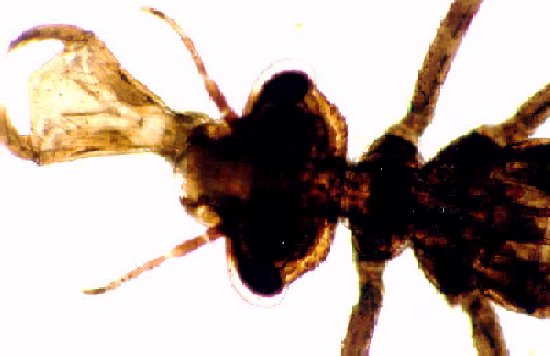Disclaimer & Copyright Notices; Optimized for the MS Internet Explorer
(Dragonflies and Damselflies)
Soil & Water Conservation Society of Metro Halifax (SWCSMH)

Suborder: Zygoptera (Damselfly); View: dorsal view of head and hinged mask
Updated: October 09, 2013 
Contents:
- Superphylum Arthropoda
- (jointed-legged metazoan animals [Gr, arthron = joint; pous = foot])
- Phylum Entoma
- Subphylum Uniramia
- (L, unus = one; ramus = branch, referring to the unbranched nature of the appendages)
- Superclass Hexapoda
- (Gr, hex = six, pous = foot)
- Class Insecta
- (L, insectum meaning cut into sections)
- Subclass Ptilota
- Infraclass Palaeopterygota
Introduction
The Odonata, comprising damsel- and dragonflies,
are the second order of palaeopteran insects and share with them the
archaic wing articulation. Fossil Odonata are known from the late
Paleozoic. Most nymphs are strictly aquatic, but some live in damp
terrestrial environments. Three ecological types of nymph are
recognized: burrowers, sprawlers, and climbers. All are predators and
use visual or tactile input to locate prey.
More is known about the chemical
ecology of odonates than of mayflies. Solutes in the environment of the
nymphal odonate can influence distribution; for example, there are
calcicole and calcifuge species. Salinity and other chemical factors
also influence their distribution. Temporal and spatial differences in
trophic niches appear to account for the common occurrence of high
species diversity in some habitats.
This order belongs to the primitive
infraclass Paleoptera. They are among the most ancient flying insects;
their ancestors appeared during the Carboniferous period 280-350
million years ago. Dragonflies of the Carboniferous period reportedly
had wingspans of 75 cm, four times that of the largest extant species.
Odonates comprise two suborders, the Anisoptera (dragonflies) and
Zygoptera (damselflies). The taxonomy of this order is relatively well
known among the aquatic insects, since nymphs (or naiads) are typically
very conspicuous and well studied. 194 species are reported to occur in
the whole of Canada.
Life History and Habitat
Odonates are hemimetabolous, with relatively
long-lived adults (several weeks to several months). After
fertilization, the eggs are deposited into the water, onto substrata in
or near the water, or into submersed parts of macrovegetation. Egg
development, as in most invertebrates, is temperature-dependent; nymphs
hatch after about two to five weeks of egg development. Growth in the
nymphal stages is quite variable, especially in relation to temperature
and food supply. Within a range of about five weeks to five years, 10
to about 20 instar moltings occur. The mature nymphs often leave the
water on some emergent substratum as aerial adults. In cool-temperate
and higher altitude warm-temperate regions, the majority of species are
univoltine or semivoltine (one generation in 2 years).
The odonate nymphs are almost
entirely littoral in habitat, living among macrovegetation and littoral
sediments, and burrowing into surficial sediments. The nymphs have
fairly high respiratory demands and oxygen requirements.
Differences between the Anisoptera and the Zygoptera
(Williams & Feltmate, 1992)
Anisoptera (dragonflies)
![[Img-dragonfl.gif]](../dragonfl.gif) . . | Zygoptera (damselflies)
![[Img-damselfl.gif]](../damselfl.gif) |
| Hindwings broader at base, held horizontally or slightly depressed at rest. Strong fliers. | Wings of equal size, narrow at base, held vertically at rest. Weaker fliers. |
| Eyes not projecting from sides of head. | Eyes bulbous and prominent. |
| Most families with reduced or vestigial ovipositors. | Females with well developed ovipositors. |
| Supra-anal plate present in males. | Supra-anal plate vestigial. |
| Nymphs robust, with rectal gills. | Nymphs slender, with paddle-like caudal gills. |
| Eggs usually laid at water surface or on surfaces of aquatic plants. | Eggs inserted into stems of aquatic plants. |
Feeding
Odonate nymphs are strictly predaceous,
using their modified extensible labium or "mask" to capture insect,
crustacean, molluscan, or oligochaete prey. They have even been
reported to consume small vertebrates. Some species burrow in the
substrate and ambush prey that they detect by tactile or vibrational
cues. Other species more actively stalk their prey. Odonates are one of
the few orders of aquatic insects whose immature stages have eyes well
developed for hunting. Adult odonates have large compound eyes to
detect insect prey, which they grasp with their legs while flying.
Examples of Odonata:
![[Coenagrionidae.jpg]](../damsel.jpg)
Suborder: Zygoptera (Damselfly); Family: Coenagrionidae
View: ventral
![[Calopterygidae.jpg]](../calop.jpg)
Suborder: Zygoptera (Damselfly); Family: Calopterygidae
View: lateral view of head and hinged mask
![[Libellulidae.jpg]](../libmask.jpg)
Suborder: Anisoptera (Dragonfly); Family: Libellulidae
View: dorsal view of hinged mask
References and web URLs:
- Hutchinson, G.E. 1993. A Treatise on Limnology. Vol. IV, The Zoobenthos. Ed. Y.H. Edmondson. John Wiley & Sons, Inc. Xx, 944pp.
- Narf, R. 1997. Midges, bugs, whirligigs and others: The
distribution of insects in Lake "U-Name-It". Lakeline. N. Am. Lake
Manage. Soc. 16-17, 57-62.
- Peckarsky, B.L., P.R. Fraissinet, M.A. Penton, and D.J. Conklin,
Jr. 1990. Freshwater Macroinvertebrates of Northeastern North America.
Cornell Univ. Press. xii, 442pp.
- Wetzel, R.G. 1983. Limnology. 2nd ed. Saunders College Publishing. Xii, 767pp, R81, I10.
- Williams, D.D., and Feltmate, B.W. 1992. Aquatic Insects. CAB International. ISBN: 0-85198-782-6. xiii, 358p.
![Freshwater Benthic Ecology and Aquatic Entomology Homepage]](../../VIEW/ICON/homepage.gif)

We salute the Chebucto Community Net (CCN) of Halifax, Nova Scotia, Canada for hosting our web site, and we applaud its volunteers for their devotion in making `CCN' the best community net in the world


![[Img-dragonfl.gif]](../dragonfl.gif) .
.![[Img-damselfl.gif]](../damselfl.gif)
![[Coenagrionidae.jpg]](../damsel.jpg)
![[Calopterygidae.jpg]](../calop.jpg)
![[Libellulidae.jpg]](../libmask.jpg)